Stability and dynamical effects of water on deck on the survivability of small fishing vessels
Alberto Francescuttoa
Gabriele Buliana
Manuel Urcia Lariosb
Maximiliano Arroyo Ulloab
Abstract
Starting from the analysis of casualties at sea involving small fishing vessels (Lbp<24 m), the paper presents the results of an experimental study on the capsizing resistance in beam or following steep or high waves of scale models in the towing tank of University of Trieste. The physical mechanisms leading to capsizing are highlighted and the experimental result are compared with existing theoretical approaches. The results stress the importance of deck wetness and of the presence of fishing nets as wave trappers on the probability of capsizing. The importance of complying with the existing regulations for dimensioning the freeing ports, although only voluntary, appears also an element of paramount importance.
En la Universidad de Trieste se ha desarrollado un plan de investigación en seguridad y estabilidad del buque. La investigación se dirige principalmente a mejorar el conocimiento de los movimientos de grande amplitud del buque, con particular atención al movimiento de balanceo en diversas condiciones de la ola, y al efecto del chapoteo del agua a bordo.
La importancia del agua en la cubierta con la capacidad de volcar pequeños pesqueros, de puntal bajo y francobordo, cubierta grande, en olas de grande altura y/o inclinación, se ha confirmado en base de los experimentos conducidos después de accidentes en el mar. Particularmente, la degradación posible de la estabilidad, debida al agua atrapada en las redes, es relevante a los estudios de la seguridad del buque. Finalmente, la altura de ola crítica propuesta por Dahle y otros, se confirma para los buques muy pequeños en olas de través. Sería interesante extender en el caso de olas de popa, considerando que actualmente el criterio más acreditado de la estabilidad refiere a un mecanismo que vuelca en viento y mar de través…
Key words: Fishing vessels, Stability, Water on deck, Sloshing, Capsizing, Roll motion
Resumen
En la Universidad de Trieste se ha desarrollado un plan de investigación en seguridad y estabilidad del buque. La investigación se dirige principalmente a mejorar el conocimiento de los movimientos de grande amplitud del buque, con particular atención al movimiento de balanceo en diversas condiciones de la ola, y al efecto del chapoteo del agua a bordo.
La importancia del agua en la cubierta con la capacidad de volcar pequeños pesqueros, de puntal bajo y francobordo, cubierta grande, en olas de grande altura y/o inclinación, se ha confirmado en base de los experimentos conducidos después de accidentes en el mar. Particularmente, la degradación posible de la estabilidad, debida al agua atrapada en las redes, es relevante a los estudios de la seguridad del buque. Finalmente, la altura de ola crítica propuesta por Dahle y otros, se confirma para los buques muy pequeños en olas de través. Sería interesante extender en el caso de olas de popa, considerando que actualmente el criterio más acreditado de la estabilidad refiere a un mecanismo que vuelca en viento y mar de través…
Palabras claves: Barcos pesqueros, estabilidad, agua sobre cubierta, chapoteo, volcamiento, rolido
________________________
a Dipartimento di Ingegneria Navale, del Mare e per l’Ambiente, Università degli Studi di Trieste
e-mail: Gabriele Bulian (gbulian@units.it); Alberto Francescutto (francesc@units.it)
b Universidad Católica del Santo Toribio de Mogrovejo
e-mail: Manuel Urcia Larios (murcia@usat.edu.pe); Maximiliano Arroyo Ulloa (marroyo@usat.edu.pe)
............................................................................................................................................................
Introduction
A long term research plan is currently run at University of Trieste on Ship Safety and Stability. The research is principally aimed at improving the knowledge of large amplitude ship motions with particular regard to rolling motion in different wave conditions and to the effect of sloshing of water on board.
In particular, the behavior in waves of two fishing vessels was studied from an experimental point of view and some conclusions are drawn regarding large amplitude roll motion modeling and the effect of green water on deck [1-5]. Due to the reduced size, this low built type of fishing vessels, which is quite common in the Mediterranean, presents high difficulties in motion computation and at the same time it is very sensitive to meteomarine environment. In both cases the research was originated by court trials following the capsizing of the original vessels with loss of life and was conducted on an experimental basis. The intact ship case was investigated with the aim of clarifying the capsizing mechanisms in beam or following waves and the effect of low freeboard, relatively large deck well, small efficiency of freeing ports and the possible deterioration of stability connected with water trapped in the nets on the stern side of the deck.
The safety of fishing vessels and the Torremolinos Convention
From a comparison between the occupational fatality statistics it appears that fishing industry is one of the most dangerous. The occupational safety and health branch of the International Labor Organization (ILO) estimates that fishing has an index of fatality of 80 per 100,000 workers, or approximately 24,000 lives per year as a consequence of 25 million non fatal accidents per year [6]. In the same period the general average of occupational fatalities was only 14.5 per 100,000, fishing excluded.
The International Torremolinos Convention for fishing vessels was established in 1977 [7] to set a safety regime for the fishing vessels of 24 m in length and upwards.
The Convention contains detailed rules concerning the standards of construction, including all safety equipment, that will be essentially applied to new ships. Being considered too strict, in the following years the Convention was not ratified by the number of administrations necessary for its entering into force.
The deficiency of ratifications, together with the need to update some technical aspects, led to a new Convention, held again in Torremolinos, in 1993. This Convention issued a Protocol to the 1977 Convention. The Protocol included provisions concerning the construction, structure, subdivision and stability, machinery and electrical installations, the fire protection, fire detection and fire extinction, the protection of the crew, the life-saving appliances and arrangements, the radio-communications and the safety of navigation.
The Torremolinos Protocol will enter into force one year after having been ratified by at least 15 Administrations, representing an aggregated fleet of 14,000 fishing vessels (approximately 50% of the world fleet of fishing vessels with length 24 m or more). On February 2nd 1999 it was ratified by 5 countries only; in 2007 by 13 countries with an aggregated fleet just exceeding 3.000 vessels.
The lack of ratification of these important provisions for the improvement of safety in this delicate sector was recently discussed at the International Maritime Organization (IMO) who solicited a study to identify the actions the Organization could undertake to promote the application of Torremolinos Protocol.
We have to note, on the other hand, that most provisions of the Convention concern vessels with length of 45 m and upwards, whereas the adoption of the provisions for vessels in the range 24 m – 45 m are left to regional agreements. This was effectively done, for instance by the European Community who, under European Directive 97/70 established a harmonised safety regime for fishing vessels of 24 metres in length and over [8].
Recently, however, IMO drafted voluntary guidelines for fishing vessels in the range 12 m – 24 m [9], whereas provisions for smaller units are under discussion [10]. Following recent statistics 93 per cent of workers are on vessels below 100 GRT (roughly 90 per cent of the workers work in vessels less than 24 meters in length)…
Relevant rules from the Draft text of the revised FAO/ILO/IMO Voluntary Guidelines for the Design, Construction and Equipment of Small Fishing Vessels
Application. Unless otherwise stated, the provisions of these guidelines are intended to apply to new decked fishing vessels of 12 m in length and over, but less than 24 m in length. Nevertheless, even where not otherwise stated, the competent authority should as far as reasonable and practical give consideration to the application of these provisions to existing decked fishing vessels.
Freeing ports (§2.14). Where bulwarks on weather parts of the working deck form wells, the minimum freeing port area (A) in m2, on each side of the vessel for each well on the working deck should be determined in relation to the length (l) and height of bulwark in this well as follows:
- A=K• l , where: K = 0.07 for vessels of 24 m in length and K = 0.05 for vessels of 12 m in length; for intermediate lengths the value of K should be obtained by linear interpolation (l need not be taken as greater than 70% of the length of a vessel).
- Where the bulwark is more than 1.2 m in average height, the required (A) should be increased by
 per metre of length of well for each 100 mm difference in height.
per metre of length of well for each 100 mm difference in height.
- Where the bulwark is less than 900 mm in average height, the required area may be decreased by
 per metre of length of well for each 100 mm difference in height.
per metre of length of well for each 100 mm difference in height.
1. authority the minimum freeing port area for each well on the superstructure deck should be not less than one half the area (A), given above, except that where the superstructure deck forms a working deck for fishing operations the minimum area each side should be not less than 75% of the area (A).
2. Freeing ports should be so arranged along the 2. length of bulwarks as to provide the most rapid and effective freeing of the deck from water. Lower edges of freeing ports should be as near the deck as practicable. Two thirds of the total freeing port area per side should be provided in the half of the well nearest the lower point of the sheer curve, and some freeing port area should be placed as near the ends of the well as practicable.
3.Poundboards and means for stowage and 3. working the fishing gear should be arranged so that the effectiveness of the freeing ports will not be impaired or water trapped on deck and prevented from easily reaching the freeing ports. Poundboards should be so constructed that they can be locked in position when in use and will not hamper the discharge of shipped water.
4.Freeing ports over 300 mm in depth should 4. be fitted with bars spaced not more than 230 mm nor less than 150 mm apart or provided with other suitable protective arrangements. Freeing port covers, if fitted, should be of approved construction. It should not be possible to lock freeing ports, but they may be fitted with external top-hinged flaps/shutter and internal gratings. Such arrange ments may, however, not lead to a considerable reduction of the effective freeing port area. Any shutter or external rubber flaps in freeing ports should be fastened with hinges in the upper edge. The shutter should fit freely so that they cannot get stuck. The hinges should be made of materials that are not susceptible to corrosion. There should not be any arrangements for the locking of freeing port shutters.
5.In vessels intended to operate in areas subject to 5. icing, covers and protective arrangements from freeing ports should be capable of being easily removed to restrict ice accumulation. The size of opening and means provided for removal of these protective arrangements should be to the satisfaction of the competent authority.
6. Where wells or cockpits are fitted in the 6. working deck or superstructure deck with their bottoms above the deepest operating waterline, efficient non-return means of drainage overboard should be provided. Where bottoms of such wells or cockpits are below the deepest operating waterline, drainage to the bilges should be provided.
7. Alternatively, the drainage of the wells could be 7. by pumps to the satisfaction of the competent authority.
Stability criteria (§3.2). The following minimum stability criteria should be met unless the competent authority is satisfied that operating experience justifies departure therefrom:
- the area under the righting lever curve (GZ curve) should not be less than 0.055 m-rad up to 30° angle of heel and not less than 0.090 m-rad up to 40° or the angle of flooding
 if this angle is less than 40°. Additionally, the area under the righting lever curve between the angles of heel of 30° and 40° or between 30° and
if this angle is less than 40°. Additionally, the area under the righting lever curve between the angles of heel of 30° and 40° or between 30° and  if this angle is less than 40° should not be less than 0.030 m-rad.
if this angle is less than 40° should not be less than 0.030 m-rad.  is the angle of heel at which openings in the hull, superstructures or deckhouses which cannot rapidly be closed watertight commence to immerse. In applying this criterion, small openings through which progressive flooding cannot take place need not be considered as open;
is the angle of heel at which openings in the hull, superstructures or deckhouses which cannot rapidly be closed watertight commence to immerse. In applying this criterion, small openings through which progressive flooding cannot take place need not be considered as open;
- the righting lever GZ should be at least 200 mm at an angle of heel equal to or greater than 30°. The righting lever GZ may be reduced to the satisfaction of the competent authority but in no case by more than 2•(24-L)%, with L in m;
- the maximum righting lever GZmax should occur at an angle of heel preferably exceeding 30° but not less than 25°; and
- the initial metacentric height GM 0 should not be less than 350 mm for single deck vessels. In vessels with complete superstructure the metacentric height may be reduced to the satisfaction of the competent authority but in no case should be less than 150 mm. It should be ensured that stability characteristics of the vessel will not produce acceleration forces which could be prejudicial to the safety of the vessel and crew;
- for decked vessels for which, by reason of insufficient stability data, the provisions above cannot be applied, an approximate formula for the minimum metacentric height
 for all operating conditions should be used as the criterion.
for all operating conditions should be used as the criterion.
It is to be noted that similar provisions are included in the regulations for smaller vessels under discussion [10]. The Weather Criterion is on the contrary recommended for larger fishing vessels (45 m in length and over), although the Voluntary Guidelines seem to indicate that it should be applied also in the range 12 m – 24 m as a replacement of another provision for assessment of stability in severe weather conditions [7].
Mechanisms that can lead to total ship stability failure (Capsizing)
The mechanisms that can lead to ship capsize have been the subject of a large number of studies culminated in the recent adoption at IMO of a framework and a plan of action for the development of a new generation of intact stability criteria based on the actual ship performances at sea [11, 12]. Modern terminology, developed at IMO in the frame of the discussion of the new generation intact stability criteria distinguishes the stability failures in partial and total (ship loss). The case of fishing vessels has also been studied in some detail, leading to the conclusion that the greatest danger in intact condition for beam sea is constituted by steep and high waves and the subsequent inclining moments and green water on deck [11, 12]. In longitudinal/quartering waves, on the other hand, the mechanisms of loss of stability in waves, surf-riding and broaching, and parametric rolling have been identified [5, 13-15]. These can be connected with steep waves and/or with resonance mechanisms, like parametric rolling.
It is worth noting that, in spite of the great progress of the knowledge in this field, the intact stability criteria did not progress in parallel. Today we still have the general criterion established in the ’60 as consequence of the study of Rahola of 1939 and the weather criterion established in the ’80 mostly as a consequence of studies conducted by Japanese in the ’50. Paradoxically, these criteria are considered too strict by shipowners and oversimplified by scientists…
As a consequence, they are still at the level of recommendations since none of them is yet mandatory at international level for the fishing vessels.
In the following, we report and discuss some of the results obtained recently concerning the safety from capsizing of fishing vessels. In this paper the attention is devoted to approaches based on the dynamic stability as reserve of energy against capsizing, mostly using the results of ad-hoc experiments connected with the analysis of casualties.
Beam sea
The results of the experiments done by several researchers were used by Dahle et al. [11-12] to obtain the height of a "critical" wave Hc, i.e. a steep wave capsizing the vessel, as a function of the "potential energy" E:

connected with the classical dynamical stability up to the vanishing static stability angle  or to the angle of progressive flooding
or to the angle of progressive flooding  . This led to the diagram reported in Fig. 1 where the critical wave for ships with bulwark and for ships with rail are indicated. Starting from this result, the statistical distribution of steep waves height can be used to evaluate the risk of capsizing of the vessel.
. This led to the diagram reported in Fig. 1 where the critical wave for ships with bulwark and for ships with rail are indicated. Starting from this result, the statistical distribution of steep waves height can be used to evaluate the risk of capsizing of the vessel.
The following conclusions were reached during the study:
- with corresponding
 curves, a loaded vessel is safer that one in ballast;
curves, a loaded vessel is safer that one in ballast;
- the area below the
 curve is important, and may be provided by enclosed superstructures, by low
curve is important, and may be provided by enclosed superstructures, by low  or both;
or both;
- for large angle of vanishing static stability and reasonable Δ and
 values, capsize is very unlikely;
values, capsize is very unlikely;
- models with positive
 values extending beyond 90 degrees never capsized in waves up to 10 m height.
values extending beyond 90 degrees never capsized in waves up to 10 m height.


Quartering waves: The difference between quartering, following and beam waves was brought to the attention of the scientists by the paper of Grochowalsky [13] who stressed the fact that new phenomena can appear in quartering waves, so that this case cannot be simply discussed as a superposition of the other two.
The new phenomenon can be created when the bulwark and part of the deck become submerged during the dynamic motions of a ship in quartering breaking waves and can lead to the capsize of a ship otherwise considered safe. There is, indeed a strong difference in the hydrodynamics of water on deck with respect to that of bulwark/deck in water.
Among the many conclusions of these studies, the following are relevant to this paper:
- the light loading condition was more • responsive to the wave, with greater tendency to riding, broaching and capsizing than the full load;
- the influence of forward speed is different • in the two typical loading conditions. In light loading the increase of the forward speed facilitates surf riding, broaching and capsizing, whereas in full loading the increase of forward speed reduces the probability of water on deck and capsizing.
The examined casualties
Model “A”. Ship "A" is a very small (12.4 Lbp) fishing vessel (Table. 1 and Fig. 3). The research, connected with a full scale capsizing with loss of a life while the vessel was reaching sheltered waters to escape a storm in the delta of river Po, was conducted in high waves on a 1:10 scale model equipped with instrumentation to measure roll motion. Several different loading conditions (Table. 2 and Figs 4-5), almost within the same displacement, realising centre of gravity values in the interval between the different IMO Intact Stability requests were tested in regular beam waves with steepness ranging from 1/30 to 1/10.
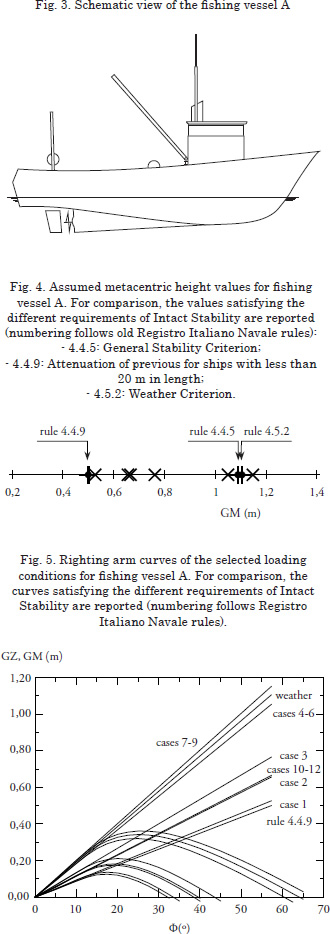
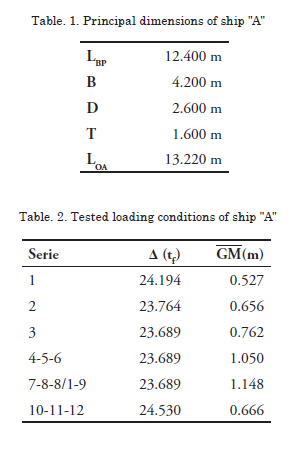
The results of the experiments indicate that:
- the maximum roll amplitude is not very sensitive to the metacentric height. An explanation of the substantial independence of roll peak amplitude on initial stability was given [3] in terms of the mechanics of ship rolling by means of the analysis of a non-linear mathematical model with coefficients based on a least square fitting to the experimental results. The results indicated that the effective wave slope coefficient (coefficient "r") is largely overestimated in the original IMO formulation.
- on the contrary, water accumulation on • deck is more sensitive to metacentric height and extension of positive stability range (Fig. 6). In several cases, water on deck resulted from the test. In particular, in the worse case, with some water on deck from a previous test, a capsizing by water accumulation was observed and recorded [1-3]. The relevant parameters of these cases were computed and reported in the diagram of critical wave height for surviving in beam waves. A good agreement with the threshold curve has been obtained.
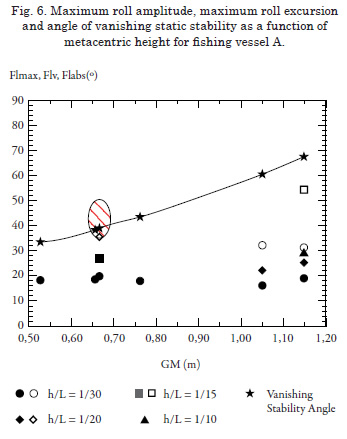
The vessel “B” and the model “C”: The second ship (Ship "B", see Table.3 and Fig. 7) is a 23.2 m Lbp fishing vessel which was lost in the gulf of Napoli in very steep quartering waves also during the return to sheltered waters as a consequence of rapidly deteriorating weather conditions.
The presence of a witness allowed to reconstruct the casualty history in terms of roll motion and stability deterioration, trim and sinkage due to water on deck (and possible progressive flooding from the deck). The ship was in full load condition. From the description of the survivors, it results that the forward speed in breaking quartering waves was voluntarily reduced to a few knots due to bad weather. The sea condition during the sinking was described by a survivor as corresponding to sea state 3-4 with some exceptional waves. The official weather reports mention a sudden deterioration of weather and a maximum seastate 6-7.
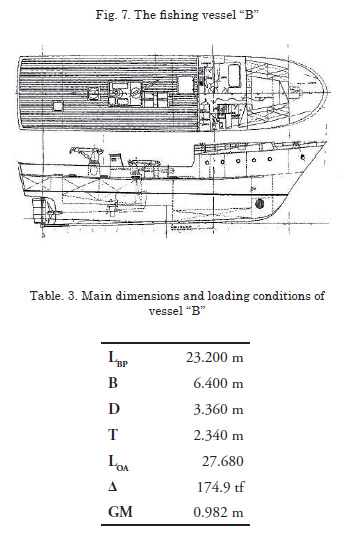
Although the capsizing happened in following/quartering conditions, in Fig. 1 the value of E corresponding to the loading condition is reported. An HC ≈ 4 m would have been sufficient to capsize the ship in beam waves. This wave height is not in contrast with the reports from the casualty, although in sheltered waters this probably could have been the characteristic of few exceptional breaking waves of a growing sea more than the property of a regular train of waves.
It was decided to obtain a better understanding of the possible mechanism of capsizing and of the role of breaking and less high waves by doing a series of experiments in towing tank. A 1:15 scale model (model "C" - Table. 4) of a vessel of similar typology already existing in the Towing Tank of the University of Trieste was ballasted to the required loading conditions and a bulwark was fitted to the deck edge. In the tested condition both the freeboard and the bulwark height above deck at stern were 0.900 m full scale. With this arrangement, the fishing vessel had a relative deck well as indicated in Fig. 2. The static effect of water on deck, as indicated in Fig. 8, computed in agreement with the indication of the Torremolinos Convention, clearly stress the risks connected with the overtopping of the bulwark by high waves.
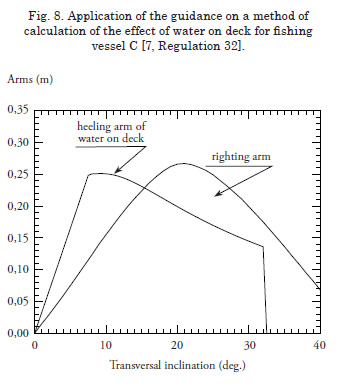
Several wavelengths and wave heights were tried in the following wave condition with the model completely free.
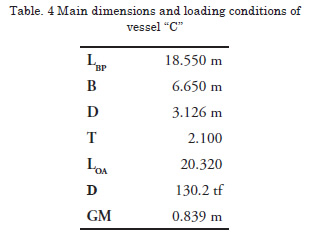
Apart from the model without anything on deck, three other configurations were tested:
- configuration with the nets on the aft part of the deck. The nets were simulated by folded fabric;
- configuration with some water preexisting on deck. To simulate the effect of a previous breaking wave some water (roughly 5-8% of the displacement or 12-20% of the deck well) was added on the stern part of the deck in coincidence with the first wave impact. This amount of water in the absence of waves produced a few degrees transversal inclination without immersing the deck edge;
- a combination of the two
In most cases there was some water on deck, but in no case, in the range of the possible wave heights of this towing tank (3m full scale), the model capsized simply by wave action or due to the presence of the nets. On the contrary, in several cases it capsized in the configuration with water on deck and with water trapped in the nets, this last leading to a more sudden and frequent capsizing. The analysis allowed to identify the threshold in terms of the wave height for the capsizing. As is evident from Fig. 1 this mechanism identifies a strongly reduced resistance to waves once a breaking/high one has partly flooded the deck. It can explain also the disagreement between visual observations of wave height.
Several capsizing cases were observed as a consequence of bad manual steering of the model to avoid it grounding on the wave absorbing beach of the towing tank after the end of the useful train of waves. The model exhibited indeed a strong tendency to sail downwave at a full scale speed of about 4-5 kn. As a result of attempts to drive it, the model went readily with deck in water or transversal to the waves and capsized.
Conclusions
The importance of water on deck in capsizing of small, low built, large deck well, vessels in steep/high waves has been confirmed on the basis of experiments conducted following casualties at sea. All the experiments leading to capsize needed some water on deck pre-existent, at least in the range of wave heights/steepnesses tested. In particular, the possible stability degradation connected with water trapped on the nets appears relevant to the studies of ship safety. It appears also that some conclusions obtained in previous research, like the effect of forward speed on the probability of capsizing in different loading conditions should be brought to the attention of the masters, since casualty to ship B could also be connected with voluntary speed reduction. Finally, the critical wave height proposed by Dahle et al. [14] is confirmed for very small vessels in beam waves. It would be interesting to extend the present analysis to investigate the reliability of this limiting value, in higher waves than those tested in this paper, for the case of following/quartering waves. We have not to forget that the presently existing stability criterion for this ship typology and size is still based on statistics of casualties, while the most accredited stability criterion based on physical modeling, not applicable to fishing vessels of the investigated size, refers to a capsizing mechanism in beam wind and waves...
A final consideration concerns the freeing ports. This seems to be the major weakness of ordinary fishing vessel constructions: small ports to avoid fish leakage and often definitely locked by thick layers of painting.
References
[1] FRANCESCUTTO, A., CONTENTO, G., “Dynamic Effects of Sloshing of Water on Board a Fishing Vessel”, Proceedings of the International Workshop on Fishing Vessel Technology (Umeda, N., Editor), Publ. Nat. Res. Inst. of Fish. Eng. Hasaki, Japan, 1997, N. 6, pp. 58-71.
[2] FRANCESCUTTO, A., CONTENTO, G., “A Case Study of the Stability of a Small Fishing Vessel in Waves”, Proc. 2nd International Conference on Marine Industry MARIND’98, P. A. Bogdanov Ed., Varna, Bulgaria, Vol. 1, pp. 127-132, 1998.
[3] D’ESTE, F., FRANCESCUTTO, A., “Experimental Study of the Dynamic Stability of a Small Fishing Vessel”, Proceedings 1st International European Inland Waterway Navigation Conference - EWIN’99, Balatonfured, Hungary, 9-11 June, 1999, pp. 106-114.
[4] BOCCADAMO, G., FRANCESCUTTO, A., RUSSO KRAUSS, G., SCAMARDELLA, A., "An Accident Investigation: Lessons Learning for Enhancing Safety of Fishing Vessels", Proceedings 1st International Congress on Maritime Transport, Barcelona, November 2001, pp. 687-698.
[5] BULIAN, G., FRANCESCUTTO, A., “Safety and Operability of Fishing Vessels in Beam and Longitudinal Waves”, International Journal of Small Craft Technology (Trans. Royal Institution Naval Architects Vol. 148, Part B2), 2006, pp. 1-15.
[6] Tripartite Meeting on Safety and Health in Fishing Industry, Note on the Proceedings, International Labour Organization, Geneva, 1999.
[7] 1993 Torremolinos Protocol and Torremolinos International Convention for the Safety of Fishing Vessels, Consolidated Edition 1995, IMO, London.
[8] European Directive 97/70/CE setting up a harmonised safety regime for fishing vessels of 24 metres in length and over, 11 December 1997.
[9] “Revised FAO/ILO/IMO Code of Safety for Fishermen and Fishing Vessels, Part B”, IMO document MSC 79/23/Add.3. See also “Voluntary Guidelines for the Design, Construction and Equipment of Small Fishing Vessels”, 2005, IMO Document MSC 79/23/Add.2, 2004.
[10] “Safety of Small Fishing Vessels - Consolidated text of the draft Safety recommendations for decked fishing vessels of less than 12 meters in length and undecked fishing vessels”, Submitted by the Secretariat, IMO Document SLF 51/5, 2007.
[11]SEVASTIANOV, N. B., "Practical and Scientific Aspects of the Stability Problem for Small Fishing Vessels", Proc. RINA Int. Conf. on Design Considerations for Small Craft, London, 1984.
[12] DAHLE, E. A., MYRHAUG, D., DAHL, S.J., "Probability of Capsizing in Steep and High Waves from the Side in Open Sea and Coastal Waters", Ocean Engng., Vol. 15, 1988, pp. 139-151.
[13] GROCHOWALSKI, S., "Investigation into the Physics of Ship Capsizing by Combined Captive and Free-Running Model Tests", Transactions SNAME, Vol. 97, 1989, pp. 169-212.
[14]UMEDA, N., RENILSON, M. R., “Broaching of a Fishing Vessel in Following and Quartering Seas”, Proceedings of the 5th International Conference on Stability of Ships and Ocean Vehicles, 1994, Vol.3, pp. 115-132.
[15] NEVES, M.A.S., PÉREZ, N.A. AND VALERIO, L. “Stability of small fishing vessels in longitudinal waves”, Ocean Engineering, Vol. 26 1999, pp. 1389–1419.
 per metre of length of well for each 100 mm difference in height.
per metre of length of well for each 100 mm difference in height. per metre of length of well for each 100 mm difference in height.
per metre of length of well for each 100 mm difference in height.







